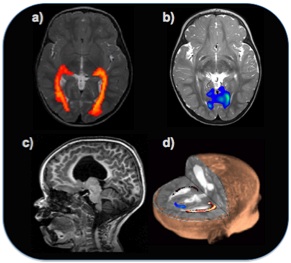|
Bridging Functional and Structural Brain Connectivity
Introduction
 |
a) Probabilistic tractography reveals a structural pathway between the lateral geniculate nucleus of the thalamus and the visual cortex. b) Functional imaging reveals activation of the visual areas in the same healthy subject. c) Shows a unilateral lesion, and d) The analysis of the structural and functional connectivity reveals that both function and structure is disrupted in the hemisphere with the lesion.
© Hammersmith Hospital, Imperial College London. (Kindly provided by Prof. A. David Edwards).
|
The brain's computation power and stability depends critically on connectivity, which governs the dynamics of signal transfer from one area to another. In fact, disturbances of brain connectivity have been implicated in a number of diseases including schizophrenia attention eficit hyperactivity disorder (ADHD), autism, alzheimer disease (AD), stroke and brain trauma. This has resulted in recent interest in network organisation and dynamics. Magnetic Resonance Imaging (MRI) can be used to derive structural and functional brain networks from diffusion weighted MRI (DWI) and resting-state functional MRI (rs-fMRI). Several tractography techniques have been developed that exploit voxel-based directional information to extract structural networks from DWI. On the other hand, functional networks are defined based on the temporal correlations between spatially remote neurophysiological events. Integrating measures of structural and functional brain connectivity holds the promise of dramatically improving our understanding of brain function and malfunction and could lead to the development of clinically useful biomarkers.
The vision of this project is to map structural abnormalities into functional networks and provide insight on how structure affects function and vice versa. Both the benefits and the challenges of this problem are tremendous. Firstly, rs-fMRI and DWI are indirect measures of function and structure, respectively. Secondly, the complexity of the problem increases exponentially with the number of brain regions. My work suggests the following approaches to regularise the problem:
utilise a prediction modeling of functional connectivity from structural connectivity. This uses out-of-sample error to select the best performing model. This is a measure on how the model will generalise to an independent data set.
extract a sparse representation of structural connectivity to limit model complexity and remove connections that are noisy and irrelevant,
consider the functional connectivity matrices as multivariate objects and hence, constrain the predicted pair-wise functional connections into the space of symmetric positive definite matrices.
utilise a generative model of rs-fMRI data based on Gaussian graphical models to describe conditional dependencies between time-series, and
use randomized lasso to provide a robust fit for correlated predictors (structural connections) and a statistical control over false positives.
Acknowledgements
The last two years I have been collaborating with the Parietal team, INRIA, FRANCE. The key suggestions on how to regularise the correlation matrices, the implementation of the Gaussian graphical model and the transition from LASSO to randomised LASSO comes from Dr. Gael Varoquaux.
The Computational, Cognitive and Clinical Neuroimaging Laboratory (C3NL) and in particular Dr David Sharp and Dr Robert Leech provided us with data and advice on connectivity-based ROIs.
Christian Ledig for helping with atlas-based segmentation.
Dr. Emma Robinson for providing the software to estimate the strength of structural connections.
Prof. Christian Beckmann for advice on sparse multiple regression and indirect connectivity.
Prof. David Edwards for recognizing early the importance of combining structural connectivity and resting-state functional connectivity.
Prof. Daniel Rueckert for the overall supervision and advice on a prediction framework and non-rigid registration. The project has been benefited from several registration tools.
This project was funded from an MRC fellowship award (G0701782).
Related Publications
F. Deligianni, G. Varoquaux, B. Thirion, D.J. Sharp, C. Ledig, R. Leech and D. Rueckert, A Framework for Inter-Subject Prediction of Functional Connectivity from Structural Networks, IEEE Trans on Med Imaging, in press.
F. Deligianni, G. Varoquaux, B. Thirion, E. Robinson, D.J. Sharp, A. D. Edwards and D. Rueckert, Relating brain functional connectivity to anatomical connections: Model Selection, NIPS-MLNI, 2011. pdf
F. Deligianni, G. Varoquaux, B. Thirion, E.Robinson, D.Sharp, A.Edwards, and D.Rueckert, A Probabilistic Framework to Infer Brain Functional Connectivity from Anatomical Connections, IPMI, 296-307, 2011. pdf
F. Deligianni, E. C. Robinson, C. F. Beckmann, D. Sharp, A. D. Edwards, and D. Rueckert, Inference of Functional Connectivity from Direct and Indirect Structural Brain Connections, ISBI, 849-852, 2011. pdf
F. Deligianni, E. C. Robinson, C. F. Beckmann, D. Sharp, A. D. Edwards, and D. Rueckert, Inference of Functional Connectivity from Structural Brain Connectivity, ISBI, 1113-1116, 2010. pdf
|